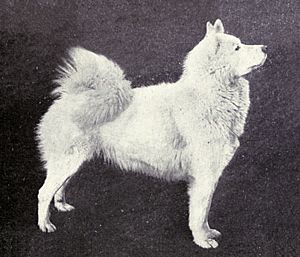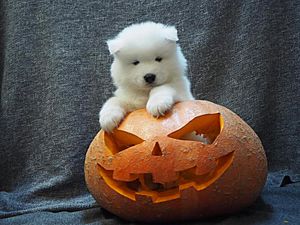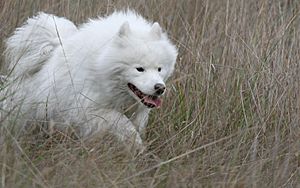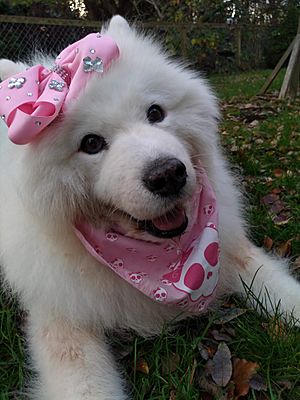Samoyed dog facts for kids
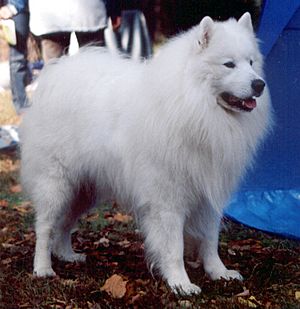 |
|||||||||||||||||||||||||
| Other names | Bjelkier Samoiedskaya Sobaka |
||||||||||||||||||||||||
|---|---|---|---|---|---|---|---|---|---|---|---|---|---|---|---|---|---|---|---|---|---|---|---|---|---|
| Origin | Russia | ||||||||||||||||||||||||
|
|||||||||||||||||||||||||
|
|||||||||||||||||||||||||
| Domestic dog (Canis lupus familiaris) | |||||||||||||||||||||||||
The Samoyed is a medium-sized dog breed. These dogs have thick, white, double-layer coats. They are a type of dog called a spitz and are named after the Samoyedic people from Siberia.
Samoyeds came from the Nenets Herding Laika dog. They were trained to help with herding animals, hunting, protecting, and pulling sleds. Most Samoyed dogs are white. Their special double coat naturally keeps dirt away. These dogs are known for being friendly and helpful. They have even been used on trips to the Arctic and Antarctic regions.
Contents
History of the Samoyed Dog
The Samoyed dog comes from an old dog breed called the Nenets Herding Laika. These dogs were used by the Nenets people in northern Siberia to herd reindeer. Scientists have studied dog DNA and found that Samoyeds are a very old breed. They existed long before many modern dog breeds appeared in the 1800s.
Studies of old dog bones from the Yamal Peninsula show that Samoyed dogs have been in that area for at least 2,000 years. This means the Samoyed dog breed has a very long and continuous history.
In the late 1800s, a famous explorer named Fridtjof Nansen bought 33 dogs from the Nenets people. He used them for his trip to the North Pole in 1893. These dogs were very strong and good at pulling sleds. They also helped hunt polar bears.
Even though many of the dogs did not survive the harsh trip, some pups were born during the journey. These dogs became the first Samoyeds that people outside Siberia learned about. They helped start the Samoyed breed we know today.
What Samoyed Dogs Look Like
Samoyed dogs are medium-sized. Male Samoyeds usually weigh between 20 and 30 kilograms (45-65 pounds). They stand about 51 to 56 centimeters (20-22 inches) tall at the shoulder. Female Samoyeds are a bit smaller. They weigh about 16 to 20 kilograms (35-50 pounds) and are 46 to 51 centimeters (18-20 inches) tall.
Their eyes are usually dark, either black or brown, and shaped like almonds. Samoyed ears are thick, covered with fur, and stand up straight. They are shaped like triangles. Most Samoyeds are pure white. Some might have a light brown tint, called "biscuit," especially on their ears.
The tail of a Samoyed is special. It curls over their back and usually touches it. When it's cold, Samoyeds might sleep with their tails over their noses to stay warm. When they are relaxed, their tails might drop down. But when they are excited or alert, the tail curls back up.
Samoyed's Special Coat
Samoyeds have a very thick, double-layer coat. The top layer has long, coarse hairs that are white with a hint of silver. This layer helps keep the dog clean. The bottom layer, called the undercoat, is soft, dense, and short. It works like a warm blanket, keeping the dog cozy in cold weather.
This undercoat sheds a lot once or twice a year. This is called "blowing coat." Even when they are not "blowing coat," Samoyeds shed fine hairs all year round. These hairs can stick to clothes and float in the air.
Some people use the shed Samoyed fur to make yarn for knitting. It feels a bit like Angora. The fur is also sometimes used to make fishing flies for fly fishing.
Samoyed dogs usually live for about 12 to 13 years.
How Samoyed Dogs Act
Samoyeds are known for being very friendly and happy dogs. This makes them not very good guard dogs because they are usually too nice to strangers! An aggressive Samoyed is very rare. They often have an alert and happy look on their faces, which people call the "Sammie smile" or "smiley dog."
Even though they are friendly, Samoyeds can be good watchdogs. They often bark when someone or something comes near their home. They are great companions, especially for children and other dogs. Samoyeds stay playful even when they get older.
If a Samoyed gets bored, it might start to dig or become destructive. Because they were bred to pull sleds, Samoyeds love to pull things. An untrained Samoyed might try to pull its owner on the leash instead of walking nicely beside them!
Fun Activities for Samoyeds
Samoyeds are smart and active dogs that enjoy many activities. They can compete in dog sports like dog agility trials, where they run through obstacle courses. They also enjoy carting, which is pulling a small cart.
Other activities include obedience competitions, showmanship, flyball (a team sport), tracking (following scents), and mushing (pulling a sled). Some Samoyeds can even be trained for herding events, showing off their natural instincts to herd animals.
Samoyed Health
Like all dog breeds, Samoyeds can have certain health issues. It's important for owners to know about these.
Kidney Health
Samoyeds can get a genetic kidney disease called Samoyed hereditary glomerulopathy. This disease is more serious in male Samoyeds. It affects how their kidneys filter blood. Young male Samoyeds might seem healthy at first, but symptoms can appear around three months of age. These can include being tired and losing muscle.
Female Samoyeds who carry the gene for this disease might have mild symptoms, but they usually don't get severe kidney failure. There is a genetic test available to check for this disease.
Other Health Concerns
Samoyeds can also be affected by other health problems:
- Diabetes: Similar to human Type 1 diabetes, where the body doesn't make enough insulin. This usually appears in middle-aged Samoyeds.
- Eye Problems: Some Samoyeds can develop a condition called progressive retinal atrophy (PRA). This causes a slow loss of vision, which can lead to blindness.
- Short Legs and Eye Issues: A rare genetic problem can cause Samoyeds to have shorter legs along with eye problems like cataracts.
- Heart Problems: A condition called pulmonary stenosis, which affects the heart, is seen more often in Samoyeds. It can make them tired easily.
- Hip Dysplasia: This is a common joint problem in many dog breeds, including Samoyeds, where the hip joint doesn't form correctly.
- Skin Condition: Samoyeds can sometimes get a rare skin disease called sebaceous adenitis.
See also
 In Spanish: Samoyedo para niños
In Spanish: Samoyedo para niños


